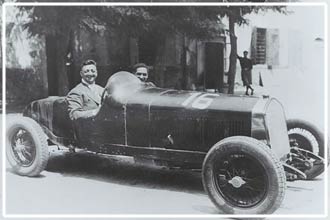 1929 The Commandatore himself, Enzo Ferrari - the man who began it all. He started his career as a driver (seen here at Verona, 1929) but soon progressed to team owner. His Scuderia Ferrari was for many years the team of choice for Alfa Romeo. By 1947, they were building their own cars. When the World Championship was instigated in 1950, Ferrari was just another team when the only game in town were the Alfa Romeo 158 Monopostos. By 1951 they were writing their own history. Today they ARE history.
1929 The Commandatore himself, Enzo Ferrari - the man who began it all. He started his career as a driver (seen here at Verona, 1929) but soon progressed to team owner. His Scuderia Ferrari was for many years the team of choice for Alfa Romeo. By 1947, they were building their own cars. When the World Championship was instigated in 1950, Ferrari was just another team when the only game in town were the Alfa Romeo 158 Monopostos. By 1951 they were writing their own history. Today they ARE history.
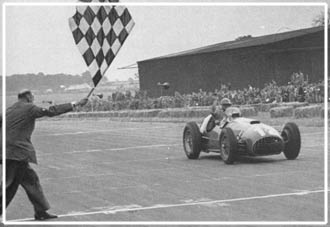 1951 Despite the promise shown by that early second place finish, it would take over a year for Ferrari to be the ones to break the post-World War II stranglehold that Alfa's 158 and the development 159 model held on Grands Prix. Jose Froilan Gonzalez took that first win in the Ferrari 375, at the former RAAF bomber base of Silverstone, that only a decade before had launched bombers towards Italy. At the next race, Villoresi and Alberto Ascari would score the first Ferrari 1-2 finish, at Ferrari's own stadium, the Autodromo Nazionale Monza.
1951 Despite the promise shown by that early second place finish, it would take over a year for Ferrari to be the ones to break the post-World War II stranglehold that Alfa's 158 and the development 159 model held on Grands Prix. Jose Froilan Gonzalez took that first win in the Ferrari 375, at the former RAAF bomber base of Silverstone, that only a decade before had launched bombers towards Italy. At the next race, Villoresi and Alberto Ascari would score the first Ferrari 1-2 finish, at Ferrari's own stadium, the Autodromo Nazionale Monza.
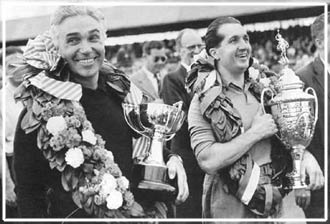 1952 At right stands Alberto Ascari, clutching the trophy for the 1952 British Grand Prix at Silverstone, alongside his madly grinning teammate Piero Taruffi. The pair had just claimed a 1-2 for Ferrari, with Ascari being the first World Championship driver to claim three wins in a row. It would get better at the next race. Against the magnificent backdrop of the Nurburgring, Ascari would win again, securing Ferrari's first World Championship, and a year later would become the first multiple world champion at the Nordschleife in 1953.
1952 At right stands Alberto Ascari, clutching the trophy for the 1952 British Grand Prix at Silverstone, alongside his madly grinning teammate Piero Taruffi. The pair had just claimed a 1-2 for Ferrari, with Ascari being the first World Championship driver to claim three wins in a row. It would get better at the next race. Against the magnificent backdrop of the Nurburgring, Ascari would win again, securing Ferrari's first World Championship, and a year later would become the first multiple world champion at the Nordschleife in 1953.
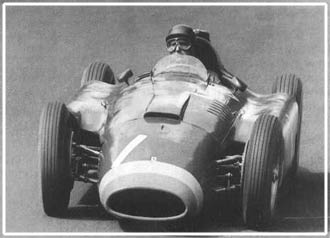
1956
Ferrari's third drivers championship was won by the Maestro, Juan Manuel Fangio. Here Fangio drives the Ferrari D50 that Lancia built, at the Nurburgring Nordschleife, to collect Ferrari's 25th World Championship win. In the absence of teams from Mercedes and Lancia, Ferrari only had Maserati to beat, and with Fangio on board how could they fail?
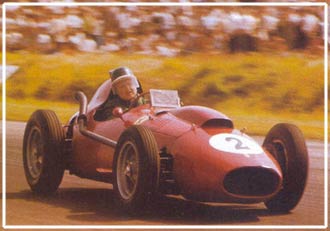 1958 1958 was a bittersweet year for Ferrari. Mike Hawthorn won the first post-Fangio title by one point from Stirling Moss, but Ferrari lost Peter Collins, dying in a crash at the Nurburgring. With his best mate gone, Hawthorn felt he could no longer continue. Weeks after becoming champion, Hawthorn died after a crash in a Jaguar on a wet public road. Here Hawthorn steers a Dino 246 tat Silverstone.
1958 1958 was a bittersweet year for Ferrari. Mike Hawthorn won the first post-Fangio title by one point from Stirling Moss, but Ferrari lost Peter Collins, dying in a crash at the Nurburgring. With his best mate gone, Hawthorn felt he could no longer continue. Weeks after becoming champion, Hawthorn died after a crash in a Jaguar on a wet public road. Here Hawthorn steers a Dino 246 tat Silverstone.
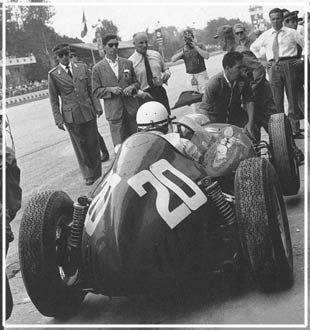 1960
1960
During the 1959 and 1960 seasons, the small rear-engined Cooper Climaxes swept all before them, heralding a revolution in racing car design. The only front engined resistance came from Ferrari. So it was somewhat fitting that Ferrari took the last front engined victory. In the pits, awaiting combat, is Phil Hill in the race winning Ferrari Dino 246.
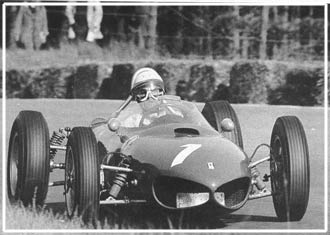 1961 Right from the start of the first season of the new 1.5 litre formula, it was obvious that Ferrari was the class of the field with their 156 'Sharknose' car. Phil Hill and Wolfgang von Trips would fight out the world championship, with the only resistance coming from Stirling Moss. It all came to a tragic end at Monza, when von Trips flew into the crowd after a clash with Jim Clark, killing the German von Trips. It made Phil Hill the first American World Champion. Here Hill is at Zandvoort in Holland, on his way to second place behind von Trips.
1961 Right from the start of the first season of the new 1.5 litre formula, it was obvious that Ferrari was the class of the field with their 156 'Sharknose' car. Phil Hill and Wolfgang von Trips would fight out the world championship, with the only resistance coming from Stirling Moss. It all came to a tragic end at Monza, when von Trips flew into the crowd after a clash with Jim Clark, killing the German von Trips. It made Phil Hill the first American World Champion. Here Hill is at Zandvoort in Holland, on his way to second place behind von Trips.
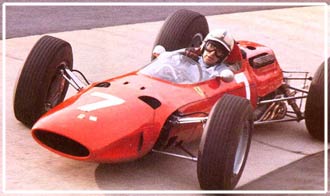 1964 The 1964 World Championship went right down to the wire, at Mexico City. Jim Clark could have won, but the battle was really between John Surtees and Graham Hill. Hill clashed with Surtees' Ferrari teammate Lorenzo Bandini, forcing Hill to pit for repairs. This meant that Surtees' second place behind Dan Gurney's Brabham was enough to claim the title. Earlier in the season, Surtees in the Ferrari 158 negotiates the Karrussell at the Nurburgring on his way to victory in the German Grand Prix.
1964 The 1964 World Championship went right down to the wire, at Mexico City. Jim Clark could have won, but the battle was really between John Surtees and Graham Hill. Hill clashed with Surtees' Ferrari teammate Lorenzo Bandini, forcing Hill to pit for repairs. This meant that Surtees' second place behind Dan Gurney's Brabham was enough to claim the title. Earlier in the season, Surtees in the Ferrari 158 negotiates the Karrussell at the Nurburgring on his way to victory in the German Grand Prix.
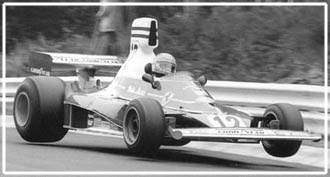 1975 It had been nine years since Ferrari had tasted the success of World Championship, and it took the great Austrian Niki Lauda to do it. Here Lauda leaps in the air in the magnificent boxer 12 engined 312T at the Nurburgring on his way to third place. Lauda secured the title at in front of the Tifosi at Monza with a race to go.
1975 It had been nine years since Ferrari had tasted the success of World Championship, and it took the great Austrian Niki Lauda to do it. Here Lauda leaps in the air in the magnificent boxer 12 engined 312T at the Nurburgring on his way to third place. Lauda secured the title at in front of the Tifosi at Monza with a race to go.
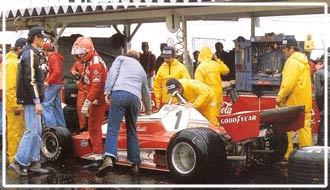 1976 In dreadful conditions at Fuji, Niki Lauda, still recovering from his awful Nurburgring shunt, decided to make a stand on driver safety, climbing out of his Ferrari 312T and walking away. This would allow James Hunt to take the championship away from Lauda at the final minute of the season. Lauda's relationship with the Scuderia was never the same again.
1976 In dreadful conditions at Fuji, Niki Lauda, still recovering from his awful Nurburgring shunt, decided to make a stand on driver safety, climbing out of his Ferrari 312T and walking away. This would allow James Hunt to take the championship away from Lauda at the final minute of the season. Lauda's relationship with the Scuderia was never the same again.
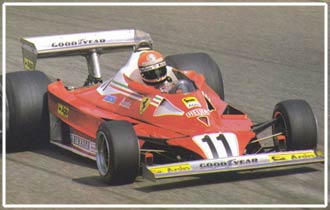 1977 Niki Lauda (Ferrari 312T2) flashes by on the straights of Monza, all but securing his second title for Ferrari. From here, Jody Scheckter was going to have to win every race just to equal Lauda. A fourth at the plunging and climbing sweeps of Watkins Glen a few weeks later would complete the task, Lauda leaving Ferrari that day to drive for Brabham. For a replacement, Ferrari looked at two drivers - one of them, a brash young Australian who earlier that year had won the Austrian Grand Prix in an unfancied Shadow; the other, a wild young French-Canadian who could drive a Formula One car like a rally driver. One became a World Champion, while the other became Ferrari's most revered driver...
1977 Niki Lauda (Ferrari 312T2) flashes by on the straights of Monza, all but securing his second title for Ferrari. From here, Jody Scheckter was going to have to win every race just to equal Lauda. A fourth at the plunging and climbing sweeps of Watkins Glen a few weeks later would complete the task, Lauda leaving Ferrari that day to drive for Brabham. For a replacement, Ferrari looked at two drivers - one of them, a brash young Australian who earlier that year had won the Austrian Grand Prix in an unfancied Shadow; the other, a wild young French-Canadian who could drive a Formula One car like a rally driver. One became a World Champion, while the other became Ferrari's most revered driver...
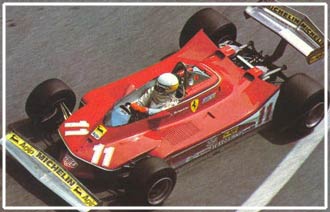 1979 South African Jody Scheckter first hit the Formula One big time back in 1974, and looked set to win the title in most of the following years. In 1979, he finally made it. Here at Monaco, Scheckter steers into one of Monaco's sharp corners in the 312T4. It would be a 1-2 in the championship, with Gilles Villeneuve finishing second. Would 1980 be Villeneuve's year? 20 years later, the Tifosi would still be waiting for that elusive Drivers' Championship.
1979 South African Jody Scheckter first hit the Formula One big time back in 1974, and looked set to win the title in most of the following years. In 1979, he finally made it. Here at Monaco, Scheckter steers into one of Monaco's sharp corners in the 312T4. It would be a 1-2 in the championship, with Gilles Villeneuve finishing second. Would 1980 be Villeneuve's year? 20 years later, the Tifosi would still be waiting for that elusive Drivers' Championship.
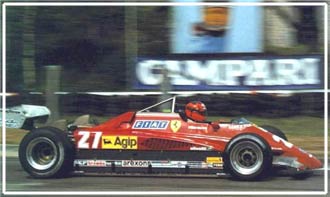 1982 What might have been. Gilles Villeneuve and the 126C2 at Imola where he and Didier Pironi would have their argument about team tactics. A few weeks later, Villeneuve was dead. A further few months later, and Pironi was greviously injured. Stand-in drivers, Patrick Tambay and Mario Andretti, would still score enough points to secure Ferrari the Constructors' title.
1982 What might have been. Gilles Villeneuve and the 126C2 at Imola where he and Didier Pironi would have their argument about team tactics. A few weeks later, Villeneuve was dead. A further few months later, and Pironi was greviously injured. Stand-in drivers, Patrick Tambay and Mario Andretti, would still score enough points to secure Ferrari the Constructors' title.
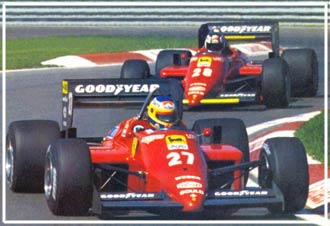 1985
1985
Early in 1985, Michele Alboreto had provided some resistance to Alain Prost's McLaren, but that faded as the season progressed. Here at Montreal, late in the race, Alboreto leads teammate Stefan Johansson on their way to a 1-2 finish in their 156/85 models.
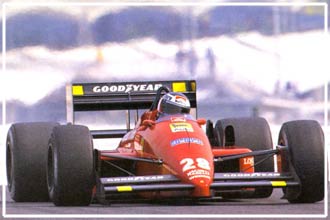 1987
1987
Gerhard Berger brought Ferrari back to the winner's circle in 1987, after a stirring drive to win the Japanese Grand Prix. Here Berger in the F187 negotiates one of Suzuka's fast sweepers.
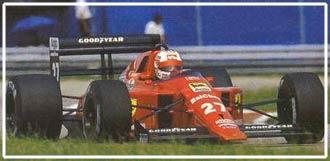 1989 In the first race of 1989, Ferrari debuted the semi-automatic gearbox - the steering wheel mounted, paddle-style gearshift now used in all F1 cars. Nigel Mansell used it to its full at Jacarepagua, winning his first race for the Scuderia, instantly becoming the darling of the Tifosi. But a WC threat would have to wait twelve months.
1989 In the first race of 1989, Ferrari debuted the semi-automatic gearbox - the steering wheel mounted, paddle-style gearshift now used in all F1 cars. Nigel Mansell used it to its full at Jacarepagua, winning his first race for the Scuderia, instantly becoming the darling of the Tifosi. But a WC threat would have to wait twelve months.
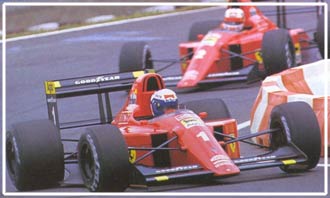 1990 100 wins! Early in the Brazilian Grand Prix at Interlagos, Alain Prost leads teammate Nigel Mansell in theisr Ferrari 641s as Prost makes his way to the landmark hundredth win for the Scuderia. Prost would take the title fight almost down to the wire, with a clash at Suzuka with Ayrton Senna preventing a title decider at Adelaide. It was later revealed by Senna that the clash was a deliberate action to take Prost out of the race.
1990 100 wins! Early in the Brazilian Grand Prix at Interlagos, Alain Prost leads teammate Nigel Mansell in theisr Ferrari 641s as Prost makes his way to the landmark hundredth win for the Scuderia. Prost would take the title fight almost down to the wire, with a clash at Suzuka with Ayrton Senna preventing a title decider at Adelaide. It was later revealed by Senna that the clash was a deliberate action to take Prost out of the race.
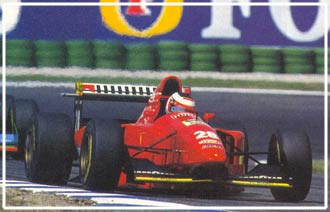 1994
1994
After not having won a race in four years, Gerhard Berger returned Ferrari
to the winner's circle at Hockenheim. Berger's 412T1B picked through the
chaos of the multiple startline accidents to take a strong win. It was not
to be a harbinger of greater fortunes though.
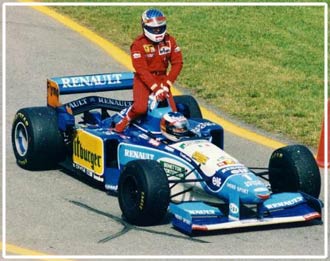 1995
1995
An extremely emotional Jean Alesi rides in on the back of Michael Schumacher's Benetton after his one and only Formula One win. Alesi, much loved by the Tifosi, had waited five years for this win. Could Ferrari be on the way back?
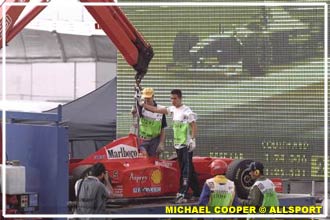 1997 Michael Schumacher was in a position to challenge Jacques Villeneuve for the title at Jerez. Villeneuve was in second place, looking at the back of Schumacher's car, closing in at around two third distance. Suddenly, Villeneuve was alongside, and Schumacher turned in on him hard, in an apparently deliberate move to take Villeneuve out of the race. However, it only succeeded in putting Schumacher out of the race.
1997 Michael Schumacher was in a position to challenge Jacques Villeneuve for the title at Jerez. Villeneuve was in second place, looking at the back of Schumacher's car, closing in at around two third distance. Suddenly, Villeneuve was alongside, and Schumacher turned in on him hard, in an apparently deliberate move to take Villeneuve out of the race. However, it only succeeded in putting Schumacher out of the race.
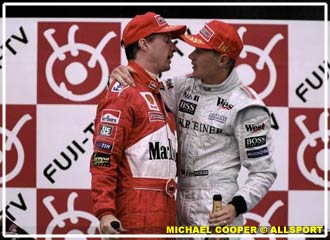 1999 Eddie Irvine brings his F399 home, to win the Malaysian Grand Prix after teammate Michael Schumacher dominated the race for him. For Irvine, it would set up a title shot against Mika Hakkinen a few weeks later in Japan. Would Ferrari fans get their day in the sun? At Suzuka however, Hakkinen was unstoppable. Ferrari picked up the consolation prize of the Constructors' Championship. But they had already won the Constructors' Championship twice since their last Drivers' crown. Would the torment ever end?
1999 Eddie Irvine brings his F399 home, to win the Malaysian Grand Prix after teammate Michael Schumacher dominated the race for him. For Irvine, it would set up a title shot against Mika Hakkinen a few weeks later in Japan. Would Ferrari fans get their day in the sun? At Suzuka however, Hakkinen was unstoppable. Ferrari picked up the consolation prize of the Constructors' Championship. But they had already won the Constructors' Championship twice since their last Drivers' crown. Would the torment ever end?
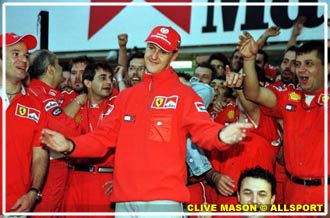 2000 At last! 21 years after Jody Scheckter won Ferrari's ninth Drivers' title, Ferrari fans now had a World Champion driver of their own again. Michael Schumacher's impressive Japanese Grand Prix win gave him the reward he, the Tifosi, and half the racing world had waited for, for many years. His record of the previous four years had been relentless - but for ill luck, poor timing and poor judgement, this might have happenned earlier. As it was, the Italian New Year celebrations started almost three months early....
2000 At last! 21 years after Jody Scheckter won Ferrari's ninth Drivers' title, Ferrari fans now had a World Champion driver of their own again. Michael Schumacher's impressive Japanese Grand Prix win gave him the reward he, the Tifosi, and half the racing world had waited for, for many years. His record of the previous four years had been relentless - but for ill luck, poor timing and poor judgement, this might have happenned earlier. As it was, the Italian New Year celebrations started almost three months early....






















